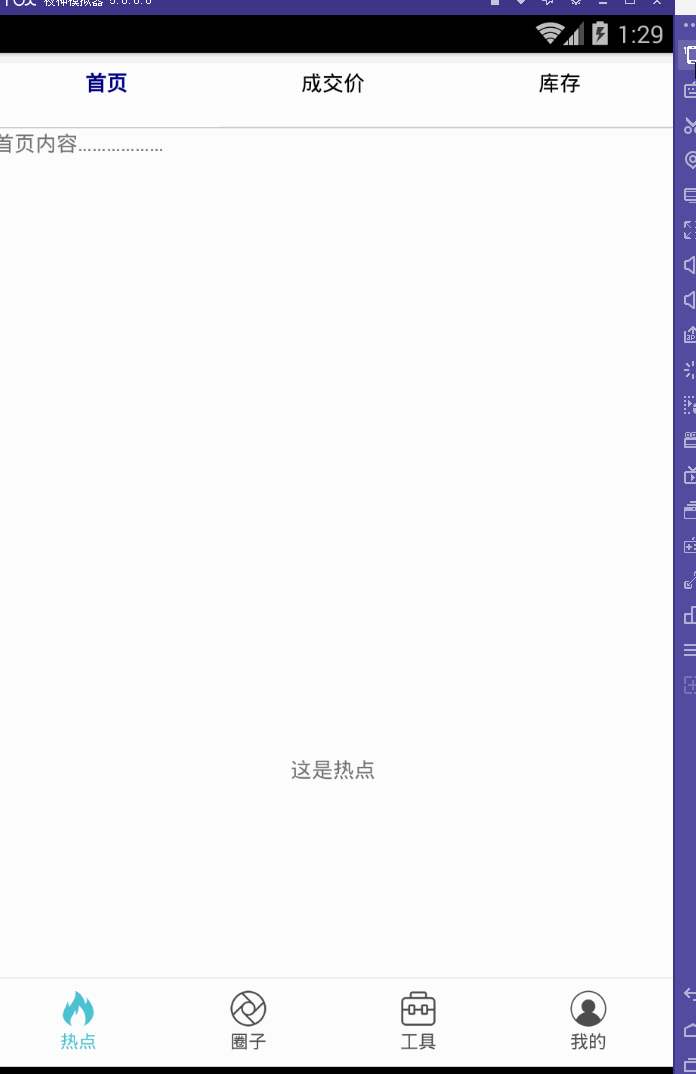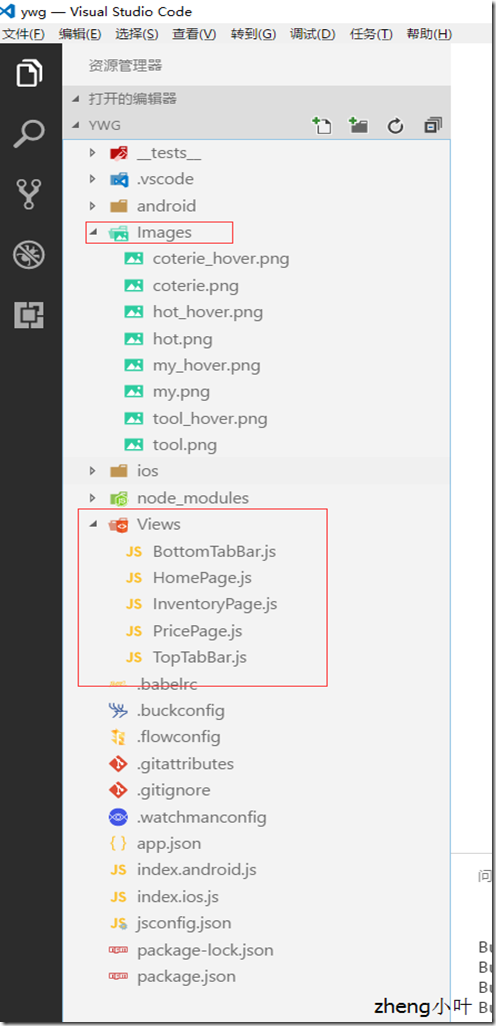React Native(四)——顶部以及底部导航栏实现方式
效果图:

一步一步慢慢来:
其实刚入手做app的时候,就应该做出简单的顶部以及底部导航栏。无奈又在忙其他事情,导致这些现在才整理出来。

1.顶部导航栏:react-native-scrollable-tab-view;文档地址:https://github.com/skv-headless/react-native-scrollable-tab-view
2.底部导航栏:react-navigation中的TabNavigator;文档地址:https://reactnavigation.org/docs/navigators/tab
3.一直想让index.android.js的代码简洁一些,苦思不得其解,直到现在才找到了一点“路径”,看这版的源代码:
index.android.js:
/**
* Sample React Native App
* https://github.com/facebook/react-native
* @flow
*/ import React, { Component } from 'react';
import {
AppRegistry,
StyleSheet,
Text,
View,
Image
} from 'react-native'; //顶部导航栏
import TopTabBar from './Views/TopTabBar';
//底部导航栏
import BottomTabBar from './Views/BottomTabBar'; export default class ywg extends Component {
render() {
return (
<View style={{flex:1}}>
<TopTabBar/>
<BottomTabBar/>
</View>
);
}
} AppRegistry.registerComponent('ywg', () => ywg);

怎样?够简单吧……对了,这样的代码看起来才比较“优雅”(容忍zheng小叶正儿八经的胡说八道哦~)而主要的代码就在
//顶部导航栏
import TopTabBar from './Views/TopTabBar';
//底部导航栏
import BottomTabBar from './Views/BottomTabBar';
这两个红色的文件中。
【重点注意】将两个Component同时使用的时候,一定要在最外层的View上定义样式,否则任你怎样摆弄,它们总是不会展现“庐山真面目”,具体的文档在:http://reactnative.cn/docs/0.46/layout-props.html

这是项目文件路径。
BottomTabBar.js:
/**
* Sample React Native App
* https://github.com/facebook/react-native
* @flow
*/ import React, { Component } from 'react';
import {
AppRegistry,
StyleSheet,
Text,
View,
Image
} from 'react-native'; //底部导航栏
import { TabNavigator } from "react-navigation"; class Home extends React.Component {
static navigationOptions = {
tabBarLabel: '热点',
tabBarIcon: ({ focused, tintColor }) => (
<Image
source={focused ? require('../Images/hot_hover.png') : require('../Images/hot.png')}
style={{ width: 26, height: 26, tintColor: tintColor }}
/>
)
};
render() {
return (
<View style={styles.container}>
<Text>这是热点</Text>
</View>
);
}
} class Circle extends React.Component {
static navigationOptions = {
tabBarLabel: '圈子',
tabBarIcon: ({ focused, tintColor }) => (
<Image
source={focused ? require('../Images/coterie_hover.png') : require('../Images/coterie.png')}
style={{ width: 26, height: 26, tintColor: tintColor }}
/>
)
};
render() {
return (
<View style={styles.container}>
<Text>这是圈子内容</Text>
</View>
);
}
} class Tools extends React.Component {
static navigationOptions = {
tabBarLabel: '工具',
tabBarIcon: ({ focused, tintColor }) => (
<Image
source={focused ? require('../Images/tool.png') : require('../Images/tool.png')}
style={{ width: 26, height: 26, tintColor: tintColor }}
/>
)
};
render() {
return (
<View style={styles.container}>
<Text>这是工具内容</Text>
</View>
);
}
}
class Mypage extends React.Component {
static navigationOptions = {
tabBarLabel: '我的',
tabBarIcon: ({ focused, tintColor }) => (
<Image
source={focused ? require('../Images/my_hover.png') : require('../Images/my.png')}
style={{ width: 26, height: 26, tintColor: tintColor }}
/>
)
};
render() {
return (
<View style={styles.container}>
<Text>这是我的内容</Text>
</View>
);
}
} const BottomTabBar = TabNavigator(
{
Home: {
screen: Home,
},
Circle: {
screen: Circle,
},
Tools: {
screen: Tools,
},
Mypage: {
screen: Mypage,
},
},
{
tabBarOptions: {
activeTintColor: '#4BC1D2',
inactiveTintColor: '#000',
showIcon: true,
showLabel: true,
upperCaseLabel: false,
pressColor: '#823453',
pressOpacity: 0.8,
style: {
backgroundColor: '#fff',
paddingBottom: 0,
borderTopWidth: 0.5,
borderTopColor: '#ccc',
},
labelStyle: {
fontSize: 12,
margin: 1
},
indicatorStyle: { height: 0 }, //android 中TabBar下面会显示一条线,高度设为 0 后就不显示线了
},
tabBarPosition: 'bottom',
swipeEnabled: false,
animationEnabled: false,
lazy: true,
backBehavior: 'none',
}); const styles = StyleSheet.create({
container: {
flex: 1,
justifyContent: 'center',
alignItems: 'center',
backgroundColor: '#fff',
}
}); module.exports = BottomTabBar;
TopTabBar.js:
/**
* Sample React Native App
* https://github.com/facebook/react-native
* @flow
*/ import React, { Component } from 'react';
import {
AppRegistry,
StyleSheet,
Text,
View,
Image
} from 'react-native';
import HomePage from '../Views/HomePage';
import PricePage from '../Views/PricePage';
import InventoryPage from '../Views/InventoryPage'; //顶部导航
var ScrollableTabView = require('react-native-scrollable-tab-view'); export default class TopTabBar extends Component {
render() {
return (
<ScrollableTabView
tabBarUnderlineStyle={{backgroundColor:'#fff'}}
>
<HomePage tabLabel="首页" />
<PricePage tabLabel="成交价" />
<InventoryPage tabLabel="库存" />
</ScrollableTabView>
);
}
}
module.exports = TopTabBar;
而关于这些的详细介绍可以参考这里(老大的小结):http://www.cnblogs.com/vipstone/p/7516115.html?utm_source=tuicool&utm_medium=referral;
美中不足:
怎样才能实现顶部栏、底部栏控制各自部分功能呢?留下来的~~~

PS:尴尬的事情猝不及防的发生了……
一直想不明白,顶部导航栏跟底部导航栏同时存在的情况下,怎样控制各自的功能呢?于是再请教完做手机开发的同事后才恍然大悟,原来自己想的顶部导航栏根本不是顶部导航栏,简言之就是自己把布局搞错了!明明只是有底部导航栏,而所谓的“顶部导航栏”也只是底部导航栏中的第一小部分里面嵌套着一个轮播组件,才会给人以错觉,啊啊啊……事实真相居然是这样的~

React Native(四)——顶部以及底部导航栏实现方式的更多相关文章
- React Native 的组件之底部导航栏 TabBarIOS(一)
import React,{Component}from 'react'; import { AppRegistry, StyleSheet, Text, View, TabBarIOS, } fro ...
- React native中DrawerNavigator,StackNavigator,TabNavigator导航栏使用
import React from 'react'; import { View, Text,Button } from 'react-native'; import { DrawerNavigato ...
- Android学习笔记- Fragment实例 底部导航栏的实现
1.要实现的效果图以及工程目录结构: 先看看效果图吧: 接着看看我们的工程的目录结构: 2.实现流程: Step 1:写下底部选项的一些资源文件 我们从图上可以看到,我们底部的每一项点击的时候都有不同 ...
- Flutter - 创建底部导航栏
之前写过的一篇文章介绍了 Flutter - 创建横跨所有页面的侧滑菜单, 这次就一起来学习一下底部导航栏. 底部导航栏在ios平台上非常常见,app store就是这样的风格.还有就是大家最常用的微 ...
- TextView+Fragment实现底部导航栏
前言:项目第二版刚上线没多久,产品又对需求进行了大改动,以前用的是左滑菜单,现在又要换成底部导航栏,于是今天又苦逼加班了.花了几个小时实现了一个底部导航栏的demo,然后总结一下.写一篇博客.供自己以 ...
- iOS开发笔记13:顶部标签式导航栏及下拉分类菜单
当内容及分类较多时,往往采用顶部标签式导航栏,例如网易新闻客户端的顶部分类导航,最近刚好有这样的应用场景,参考网络上一些demo,实现了这种导航效果,记录一些要点. 效果图(由于视频转GIF掉帧,滑动 ...
- Android底部导航栏——FrameLayout + RadioGroup
原创文章,转载请注明出处http://www.cnblogs.com/baipengzhan/p/6285881.html Android底部导航栏有多种实现方式,本文详细介绍FrameLayout ...
- Android底部导航栏创建——ViewPager + RadioGroup
原创文章,引用请注明出处:http://www.cnblogs.com/baipengzhan/p/6270201.html Android底部导航栏有多种实现方式,本文详解其中的ViewPager ...
- 二、Fragment+RadioButton实现底部导航栏
在App中经常看到这样的tab底部导航栏 那么这种效果是如何实现,实现的方式有很多种,最常见的就是使用Fragment+RadioButton去实现.下面我们来写一个例子 首先我们先在activi ...
随机推荐
- 关于Unity中的光照(五)
Mobile Diffuse Unity自带的一种shader,用的比较多,性能还可以.我们默认创建的unit shader基本和它一致,但是没有参与光照计算,看起来和Mobile Diffuse有区 ...
- 使用cssQuery选择器语法来查找元素
使用选择器语法来查找元素 问题 你想使用类似于CSS或jQuery的语法来查找和操作元素. 方法 可以使用Element.select(String selector) 和 Elements.sele ...
- 使用xshell5 从CentOS主机download资料
需要安装一个软件,步骤如下: 第一步,找出软件的完整名称: 第二步,安装该软件: 第三步,执行sz命令. 参考下面的执行过程 [root@mylinux ~]# yum provides lrzsz* ...
- struts2系列(二):struts2参数传递错误、struts2的输入错误验证
一.struts2参数传递错误 1. 基本数据类型的传递最好使用包装类,原因是struts 2.1之后使用基本数据类型如果参数为空会报错2. 日期参数的传递最好定义一个区域的属性(定义locale), ...
- EF5+MVC4系列(1) Podwerdesigner15.1设计数据库;PD中间表和EF实体模型设计器生成中间表的区别;EF5.0 表关系插入数据(一对多,多对多)
在上一篇文章中, http://www.cnblogs.com/joeylee/p/3790980.html 我们用 PD15.1 来设计了数据库,并且生成 了sql数据库,现在我们用 vs2013 ...
- AMQ5540, AMQ5541 and AMQ5542, application did not supply a user ID and password, 2035 MQRC_NOT_AUTHORIZED
Technote (troubleshooting) Problem(Abstract) As an MQ administrator you create a new queue manager i ...
- Linux Shell 基本语法
一. Linux基本命令 1.1. cp命令 该命令的功能是将给出的文件或目录拷贝到另一文件或目录中,功能十分强大. 语法: cp [选项] 源文件或目录 目标文件或目录 1.2. mv命令 用户可 ...
- utf16编码格式
UTF-16是Unicode字符集的一种转换方式,即把Unicode的码位转换为16比特长的码元串行,以用于数据存储或传递.UTF-16编码规则如下: 2.2.1 从U+D800到U+DFFF的码位( ...
- UGUI 加载图片
图片是动态加载的,然后转换为sprite赋值到ugui的按钮上 代码如下 using UnityEngine; using System.Collections; using System.IO; u ...
- 树莓派命令行配置连接wifi
iwlist scan sudovim /etc/wpa_supplicant/wpa_supplicant.conf network={ ssid="WIFINAME" ...
